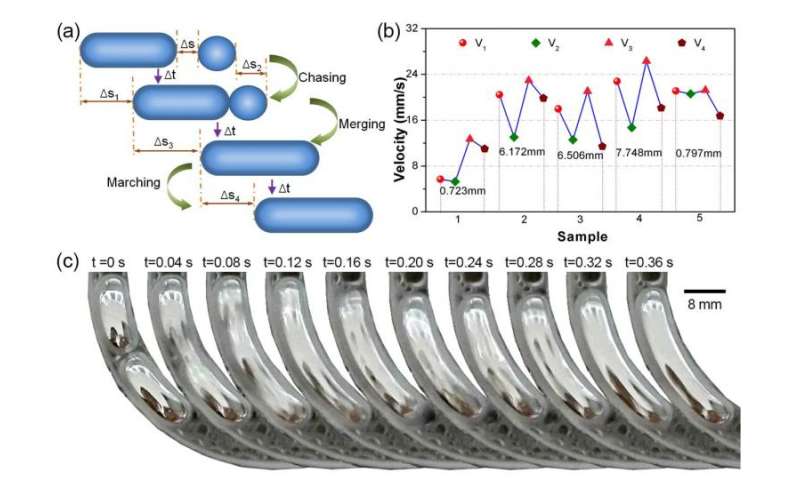Autonomous convergence and divergence of the self-powered soft liquid metal vehicles

The autonomous locomotion for a macroscopic machine remains an intriguing issue for the researchers to explore. Recently, Professor LIU Jing and his group from Tsinghua University demonstrated that as a versatile material, the liquid metal could be self-actuated when fueled with aluminum (Al) flake, and the motion thus enabled would persist for more than an hour at a quite high velocity.
Based on the previous study, the present work proposed to realize a much larger liquid metal machine, which could autonomously move and accelerate with the increase of temperature. More surprisingly, when dividing a large running liquid metal vehicle into several smaller ones, each of them still maintains its traveling state along the original track. If several dispersive vehicles moved close to each other, they could coalesce seamlessly, and then still kept moving forward. This finding has been published on Science Bulletin, 2015.
Conventionally, it has been a challenge for a machine to achieve self-assembly without manual intervention. Generally, the self-assembly indicates a reversible process that pre-designed discrete modules could be assembled together. When assembling the machine, each module is bound to the other. And if the discrete modules are needed to work individually, each of them should be equipped with separate power sources. These processes often results in a complex design and fabrication.
Inspired by the liquid metal enabled autonomous motion, which tactfully obviated the need of external energy, the present study demonstrated that through elevating the temperature, a much larger self-propelled machine could be achieved. More importantly, during the moving process, if dividing a large machine into several smaller separately running vehicles, each of them still resumes its traveling state along the original track and chases each other. If the volumes of such dispersive vehicles were close to each other, and they were all squeezed in the channel, the vehicles would move synchronously with oscillation. Otherwise, such self-motion would become desynchronized with interval between the inequable vehicles decreased gradually. If their volumes were significantly different, and the smaller vehicles were not squeezed in the channel, the faster vehicle would overtake the slower ones, until finally coalesced seamlessly. The assembled vehicle could deform itself along with change of its velocity.
This finding may shed light on future researches on smart material, fluid mechanics and soft matter to self-fueled machine. It would also offer opportunities for constructing self-reconfigurable soft robots.
More information:
Zhang Jie, YAO Youyou, LIU Jing, Autonomous convergence and divergence of the self-powered soft liquid metal vehicles, Science Bulletin, 2015. link.springer.com/article/10.1007%2Fs11434-015-0786-z
Provided by Science China Press